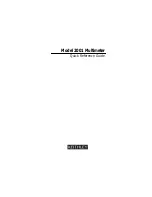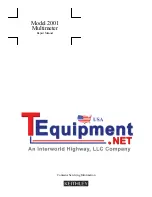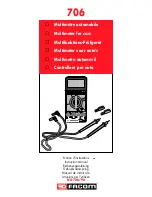
16
DATA VOICE MULTIPLEXORS
The voice channels are available in two options:
• 2W FXO interface: Two-wire 600-ohm analog interface and FXO loop-start
signaling for direct connection to PABX extension lines.
• 2W FXS interface: Two-wire 600-ohm analog interface and FXS loop-start
signaling for direct connection of a subscriber telephone set. The FXS
interface generates the required line-feed current and ringing voltage locally.
The FXO and FXS options are usually operated in a link, with the FXO interface
at the PABX side, and the FXS interface on the subscriber’s side. In addition, two
FXS interfaces can also be operated in a link, to provide PLAR (Private Line with
Auto-Ring) telephone service.
2.1.3 D
ATA
-C
HANNEL
F
EATURES
The Data Voice Multiplexor’s data channel is a synchronous channel. The
electrical interface of the data channel is user-selectable (X.21, V.35, V.36/RS-449,
RS-530, or RS-232). The data channel is terminated with a DB15 female connector,
wired for ITU-T X.21. When a different interface is selected, an appropriate
adapter cable (available on a special-quote basis) must be inserted between the
DVM and the cable connecting to the user’s equipment.
The data channel can operate at rates of 0.8 to 252.8 kbps, depending on the
selected mode and the main link’s data rate. Note that when the RS-232 interface is
selected, the maximum data rate is limited by the electrical characteristics of this
interface, which usually cannot work above 64 kbps.
The data-channel interface is configured as a DCE; that is, it provides timing
signals to the user’s equipment—the receive and transmit timing is derived from
the main link clock.
The data channel is transparent to users’ data. The control lines generated by
the data-channel interface are Carrier Detect (CD) and Clear to Send (CTS). For
the RS-232 interface, the DSR line is also provided. Those lines are asserted when
the DVM is operating normally (that is, when the configuration is valid, the DVM is
synchronized, and the channel is not being tested). For interfaces other then
RS-232, the CD line can be externally connected to the DSR line to enable
operation of terminal equipment that needs DSR to tell that the other device is
active, such as IBM equipment.
The channel interface does not include control lines for hardware flow control;
therefore, when users’ applications require flow control, the users’ equipment
must use software flow control.
Содержание MX270A
Страница 69: ...68 NAME...
















































